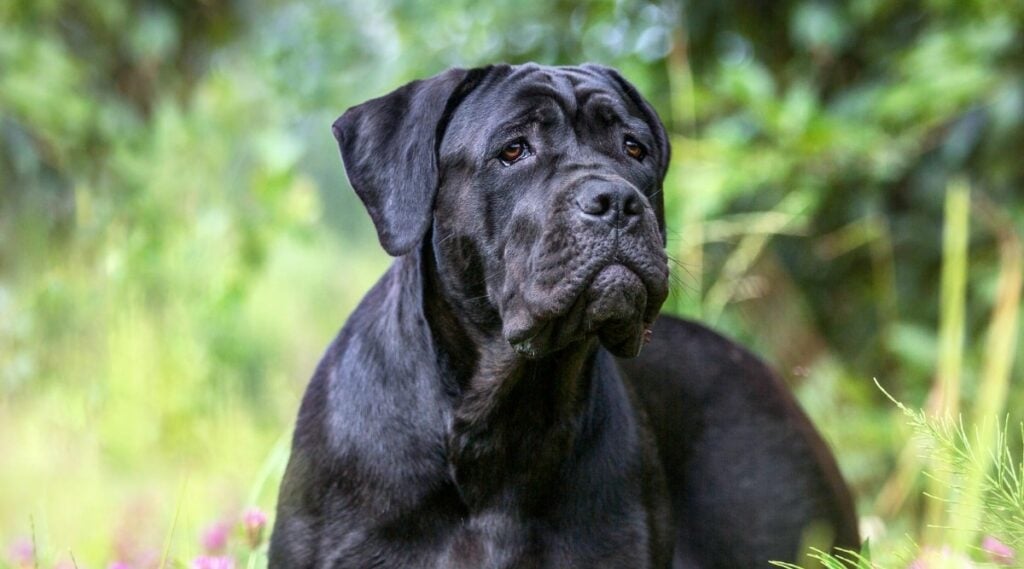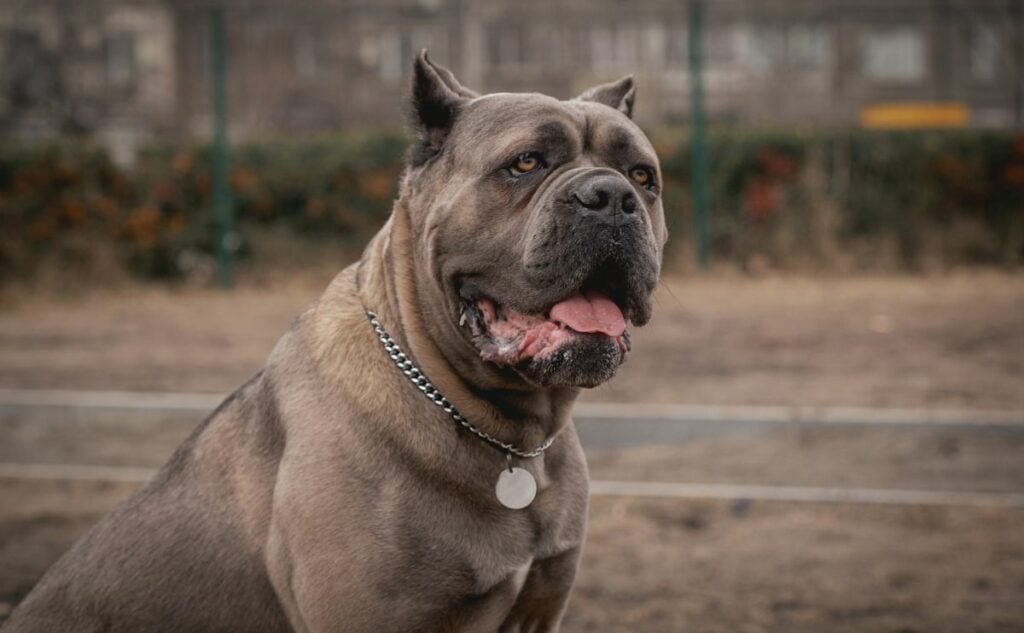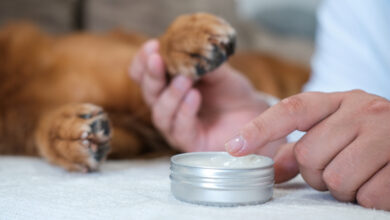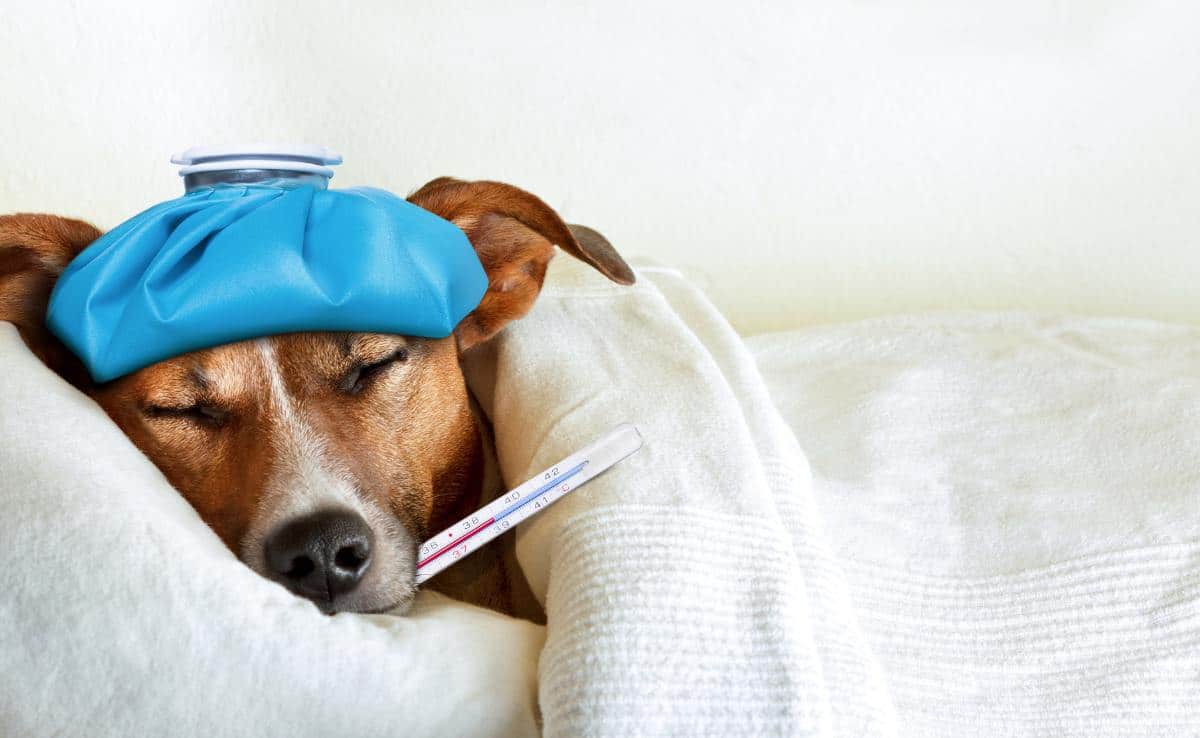10 Common Cane Corso Health Issues
When you purchase through links on our site, we may earn a commission. Here’s how it works.
The Cane Corso, also known as an Italian Mastiff, is a large breed that’s quickly gaining popularity in the U.S., the U.K., and other locations around the world. For those who love a large furry friend, Cane Corsi (the official plural for their name) are gentle pups who pack a ton of love in their huge bodies. However, like all purebreds, they’re prone to some serious health concerns.
Table of Contents
Fortunately, the Cane Corso is a relatively healthy breed compared to many purebreds. I’ll fill you in on the most common Cane Corso health issues, including symptoms and treatment options, so you can be well-informed about what you could face down the road with your precious pup (or if you’re still considering adding a Corso to your family).

10 Common Cane Corso Health Issues
I spoke with Dr. Rebecca MacMillan, BVetMed, BSAVA, PGCertSAM, MRCVS, to gain insights from a practicing veterinarian regarding health concerns in Shih Tzus. Dr. MacMillan is a veterinarian and surgeon at a small animal clinic in the U.K.
Drawing from Dr. MacMillan’s expertise and my research, I’ve compiled a list of the top 10 prevalent health issues affecting Pomeranians. It’s crucial to be aware of the symptoms associated with each condition so that you can reach out to your veterinarian promptly if you observe any signs.
1. Hip & Elbow Dysplasia
Unfortunately, elbow and hip dysplasia in Cane Corso dogs is quite common. The 2023 testing statistics from the Orthopedic Foundation of America (OFA) indicate that over 37% of Corso’s tested had hip dysplasia and 21% suffered from elbow dysplasia. Both conditions are caused by the abnormal development of the joints, leading to increased discomfort, reduced mobility and often arthritis.
Symptoms
- Pain or discomfort during exercise
- Lameness
- Stiff back or front legs
- “Bunny hop” like run (with hip dysplasia)
- Stiffness getting up or running
- Struggling to walk up the stairs or take long walks
- Difficulty getting up from resting
- Abnormal gait
- Lack of enjoyment with physical activities that were previously enjoyable
Diagnosis & Treatment
Your veterinarian will palpate the elbow or hip joint and take an X-ray of the afflicted joint to make the diagnosis. Treatment options for hip dysplasia may include joint supplements, physical therapy, anti-inflammatory drugs, and weight control, depending on the condition’s severity.
Surgery is frequently required in more severe cases of hip dysplasia. Total hip replacement is the most successful surgical procedure. Surgery is frequently necessary for the treatment of elbow dysplasia.
2. Osteochondritis Dissecans (OCD)
The developmental joint disorder osteochondritis dissecans (OCD) can affect large, rapidly growing breeds between six and nine months old. OCD occurs when a joint’s cartilage separates from the end of the bone, most commonly in the shoulder in Cane Corso puppies.
However, it can also affect the elbow, hip, knee, or ankle. Genetics plays a factor in OCD, but it can occur in large dogs whose diets include too much protein, calcium, and energy.
Symptoms
- Not bearing weight on the leg
- Limping or intermittent lameness
- Pain
- Swelling
- Warm to the touch
Diagnosis & Treatment
A physical examination, medical history, and imaging tests like X-rays are all part of the diagnosis process. In some cases, an ultrasound or an arthroscopic examination may be needed. Conservative treatment options include anti-inflammatory drugs, joint supplements, major exercise restrictions, and at-home range-of-motion exercises. Surgery is usually required in more serious cases or if conservative treatment doesn’t improve the joint.
3. Cranial Cruciate Ligament (CCL) Tears
The likelihood of cranial cruciate ligament (CCL) tears is higher in Corsi due to their size, energy levels, and genetic composition. Similar to human ACL injuries, CCL injuries occur when the knee joint’s ligament rips, degrades, or occasionally ruptures entirely.
This may occur as a result of the ligament gradually deteriorating over time, or it may occur abruptly while the dog is rushing and makes a quick turn. Dogs who experience a tear or rupture in one CCL are more prone to experience the same issue in the other knee.
Symptoms
- Limping
- Barely putting any weight on the affected hind leg
- Walking on three legs
- Difficulty getting up
- Sitting on one side
- Audible clicking or popping in the joint
- Swollen knee
Diagnosis & Treatment
Range of motion testing and X-rays are typically required for the diagnosis. Most large dogs, like the Cane Corso, require orthopedic surgery to stabilize the knee. Recovery from CCL surgery usually involves pain relief, anti-inflammatory medications, and rehabilitative therapy. Weight management is crucial because dogs with CCL injuries almost always develop arthritis later in life.
4. Canine Bloat
“Gastric dilatation volvulus (GDV), or canine bloat, is a risk for large deep-chested dogs such as Cane Corsos,” says Dr. MacMillan. “In this condition the stomach bloats and twists on itself.”
This often occurs when dogs eat or drink excessively or too quickly. With GDV, a dog’s stomach becomes overly inflated with gas, food, or liquid.
This ballooning can cause the stomach to twist, cutting off blood flow. The enlarged stomach may also compress major blood vessels, impeding blood flow back to the heart and potentially resulting in shock. GDV can develop swiftly and is always treated as a medical emergency.
Symptoms
The pain associated with GDV is intense and can strike suddenly. A dog might appear perfectly fine one moment and then show alarming symptoms the next.
- Pacing
- Agitation
- Frequent dry-heaving or vomiting foam or mucus
- Distended abdomen that’s hard to the touch
- Whining
- Shallow breathing
- Collapsing
Diagnosis & Treatment
To assess whether the stomach has twisted, X-rays and other diagnostic tests might be required. A veterinarian may first attempt to insert a stomach tube; however, if the stomach is indeed twisted, this could prove impossible. In such cases, a large needle or catheter may be used to puncture the skin and alleviate the pressure within the stomach.
Prompt shock treatment is essential, which includes administering intravenous fluids and emergency medications. After stabilizing the dog, surgery will be needed to properly reposition the stomach.
4. Dilated Cardiomyopathy
The primary cause of death in Corsi is dilated cardiomyopathy (DCM). The heart muscle first degenerates, becoming weaker and thinner as a result of this chronic, progressive cardiac disease. The heart’s capacity to pump blood efficiently diminishes as it continues to deteriorate. The thin heart muscle walls stretch as a result of the heart’s enlargement and elevated pressure brought on by the blood congested inside. It may also develop into lung blood congestion.
Symptoms
- Lethargy
- Weakness
- Weight loss
- Collapse
- Rapid breathing
- Breathing difficulty
- Coughing
- Abdominal distension
Diagnosis & Treatment
Diagnosis involves detecting an irregular heartbeat or murmur (arrhythmias), blood and urine tests, an electrocardiogram, and imaging such as chest X-rays or cardiac ultrasounds (echocardiogram).
There’s no cure for DCM. However, medication therapy may help slow the disease’s progression and relieve symptoms. Prescription medications are required to improve the heart’s pump function, dilate the peripheral blood vessels to reduce cardiac workload, eliminate lung congestion, and control the heart rate and cardiac arrhythmias. Prognosis is variable, but some dogs can live 6-12 months.
5. Demodectic Mange
A common Cane Corso skin issue, demodectic mange is a skin disease caused by microscopic mites (Demodex canis or Demodex injal) that live in the hair follicles. A dog’s body usually has a small number of mites that are harmless, but demodectic mange occurs when they increase rapidly.
Dogs suffering from demodectic mange either have localized areas of the disease or their entire body becomes infected, referred to as generalized demodectic mange. Secondary skin infections can develop, complicating the healing and treatment process.
Symptoms
- Hair loss (usually begins on the face)
- Pustules (small skin bumps that contain pus or fluid)
- Itchy skin
- Redness and welts
- Crusty lesions
- Secondary skin infections
- Thickening and darkening of the skin
Diagnosis & Treatment
Your vet will take skin scrapings and look at them under a microscope to diagnose demodectic mange. Vets usually treat localized mange with topical medication, but generalized mange typically requires long-term oral or topical medications.
In some cases, vets may use an injectable medication called doramectin. Your vet may also prescribe a daily dose of Ivermectin (often used to prevent heartworms) until the infection clears up. Secondary skin infections may need treatment through antibiotics and shampoo therapy.
One case of mange I saw in practice involved a young Cane Corso whose owners had previously declined a veterinary anti-parasite product from my colleague, which was effective against Demodex as well as fleas and other parasites. Instead, they chose to use an over-the-counter flea product and wanted to try shampooing their pet.
Sadly, the dog came back a few months later even more bald, with multiple patches all over his body. At this point, I recommended taking some simple skin scrapes and hair plucks. Multiple tiny mites were seen wriggling on the microscope slide, which confirmed the Demodex diagnosis. The owners at that point decided that they would indeed take the veterinary prescription product that was previously recommended, and the dog was cured!
– Dr. Rebecca MacMillan
6. Epilepsy
Idiopathic epilepsy, a neurological condition that results in recurring seizures because of aberrant electrical activity in the brain, is common in Cane Corsi. Experts believe there is a hereditary component to idiopathic epilepsy, albeit the exact cause is unknown. The age of onset can vary from one to six years old.
Symptoms
Many dogs experience what’s called the aura stage prior to the following signs of a seizure, where they appear anxious, fearful, or confused. Cane Corso seizures typically last 30-90 seconds.
- Stiffening of the neck, body, and legs
- Falling over to the side
- Leg paddling
- Trembling, shaking, and convulsing
- Excessive drooling
- Making a chewing motion
- Loss of bladder and bowel control
- Vocalizing
Diagnosis & Treatment
Eliminating all other potential causes of seizures is necessary to diagnose epilepsy. A comprehensive physical examination, blood and urine tests, x-rays, and an assessment of the dog’s medical history are all part of diagnostics. Additional tests, including CT or MRI imaging and bile acid and cerebrospinal fluid (CSF) testing, may be necessary in certain situations.
Many dogs do well with a daily antiseizure (anticonvulsant) medication and regular re-examinations. However, some dogs may require multiple medications to reduce their seizure frequency, but they can still experience fits intermittently. Acupuncture may also help reduce the frequency.
7. Hypothyroidism
Hypothyroidism is a chronic condition where the body cannot produce enough thyroid hormones, which slows down metabolism. This common endocrine disorder typically affects dogs in their middle age, around 6 to 7 years old, and can lead to significant health complications if left untreated. The OFA 2023 testing statistics show that of the Corsi tested, over 7% experienced thyroid problems.
Symptoms
- Unexplained weight gain
- Lethargy
- Decreased activity level
- Abnormal hair loss without itching
- Dry, dull, brittle coat
- Skin darkening
- Recurrent infections in ears and skin
- Intolerance to cold
- Slow heart rate
Diagnosis & Treatment
Veterinarians use blood tests to measure your dog’s thyroid hormone levels in order to diagnose hypothyroidism. Various tests to assess organ function may be performed based on symptoms. This disorder cannot be cured, but it can be efficiently controlled. Dogs with hypothyroidism must take an oral thyroid replacement hormone for the rest of their lives. They also need to be tested every year to make sure the medication is still working.
9. Multiple Eye Disorders
All purebreds are genetically predisposed to some ocular disorders. A report by the American College of Veterinary Ophthalmologists (ACV) showed that around 23% of Corsi had at least one eye abnormality. Most Cane Corso eye problems are of the eyelid rather than the eye itself. All of these conditions can affect both eyes, though not always simultaneously, and some may even occur together.
- Cataracts: This is a common disorder in many dogs (and humans) where the lens hardens and loses its clarity. As the cataract progresses, it becomes increasingly cloudy, obstructing light from reaching the back of the eye, ultimately resulting in vision loss. Surgical intervention is required for treatment.
- Cherry eye: This is a condition where the gland of the third eyelid, which helps produce tears, protrudes out of its normal position, resulting in a red or pink mass in the corner of the eye. Treatment requires surgery
- Entropian: Entropian causes the eyelids to roll inward, causing the lashes to rub on the eyeball. Signs include squinting, holding the eye shut, and excessive tearing. Treatment requires surgical correction.
- Ectropion: Ectropion causes the eyelids (usually the lower lids) to roll outward, creating droopy-looking eyes. Mild cases may respond to medicated eye drops, while severe cases usually require surgery.
Symptoms
Unless noted above, many eye problems share similar symptoms.
- Eye sensitivity
- Squinty eyes
- Repeated blinking
- Bloodshot or cloudy eyes
- Yellow or green discharge
10. Bone Cancer
Osteosarcoma is a type of bone cancer that is more frequently seen in larger dog breeds. This aggressive and painful condition most commonly develops in a dog’s front or back leg but may also affect the jaw, facial bones, vertebrae, or ribs.
Symptoms
- A firm swelling, which is painful to touch and possibly hot
- Limping or lameness
- Lethargy or weakness
- Loss of appetite
- Palpable mass
- Shaking or trembling (due to pain)
Diagnosis & Treatment
Osteosarcoma is particularly aggressive and has a tendency to metastasize to the lungs, making it essential to catch it early for a better prognosis. Unfortunately, by the time osteosarcoma is diagnosed, it has usually metastasized.
Diagnostics may include X-rays, CT imaging, blood and urine tests, and a biopsy. Treatment typically includes the amputation of the affected limb, followed by chemotherapy, which can help prolong and enhance your dog’s quality of life. Stereotactic radiation is used in other areas of the body.
Other Cane Corso Health Issues
Although the following concerns may not be quite as common as those above, it’s essential to know other health issues that your Corso could face.

- Obesity: Like many very large breeds, Corsi have a propensity for gaining weight easily. Learn how to determine if your pup is overweight.
- Allergies: This breed can develop allergies to food (especially proteins, like chicken) and environmental factors.
- Ear infections: Corsi with allergies or those without cropped ears are more prone to ear infections.
- Dental-Skeletal-Retinal Anomaly (DSRA): DSRA is a hereditary disease primarily affecting Cane Corso dogs, involving abnormalities in the development and growth of the skeleton and teeth. It’s also associated with progressive retinal degeneration, which results in vision loss.
- Neuronal ceroid lipofuscinsosis 1 (NCL1): NCL1 is a rare, inherited, neurodegenerative disease affecting young Corsi. Symptoms of vision loss, behavior changes, abnormal gait, and seizures progress slowly.
At-Home Dog Allergy Tests
If you are unsure what’s triggering your pup’s allergies, you may want to consider an at-home allergy test. These tests may help identify food ingredients and environmental factors that may be a problem. You can get results in a few weeks and share your report with your veterinarian to possibly narrow down your dog’s offending allergens and determine a treatment plan. However, these test kits aren’t meant to replace a vet’s diagnosis.

Average Costs For Several Common Cane Corso Health Problems
Fetch Pet Insurance says of its insured Cane Corsi that gastric issues (bloat), walking abnormalities, and eye inflammation are common illnesses they cover. As reported by Fetch, the range of average costs for these health problems are:
- Walking abnormality: $2,400-$3,600
- Gastric issues (canine bloat): $2,100-$3,500
- Eye inflammation: $450-$800
Should I Consider Pet Insurance?
While Corsi are generally healthy, you never know when an unexpected illness, genetic disorder, or accident will occur — and any dog’s medical problems can cost thousands of dollars to diagnose and treat. By covering a large portion of unexpected vet bills, pet insurance can ease the difficult decision between your finances and ensuring your beloved pet gets the essential veterinary care they need.
It’s best to insure your dog while they’re still young and before serious health issues arise, as most insurance companies typically do not cover pre-existing conditions. Check out our reviews of the best pet insurance providers for more information.

Expert Tip: Find A Reputable Breeder
Because the Cane Corso is a quickly rising popular breed, you must be sure to purchase one from a reputable breeder to help you avoid some of these hereditary medical problems. There are a lot of unscrupulous “breeders” out there now who prey on prospective owners who are looking for the latest “it” breed.
Reliable breeders screen their dogs for many of these issues to avoid passing them on to the puppies they produce. See our guide on how to find a reputable breeder for more information. Check out the Cane Corso Association of America for some specific recommendations.
Frequently Asked Questions
Here are some questions our readers ask most often about Cane Corso health problems. If you don’t see yours here, hit us up in our comments.
What Is The Life Expectancy Of A Cane Corso?
Cane Corsi have an average lifespan of 9 to 12 years, but several factors impact every pup’s lifespan, including genetics, overall health, and lifestyle.
What Do Cane Corso Dogs Usually Die From?
The leading cause of death in Cane Corsi is dilated cardiomyopathy (DCM). Canine bloat can also be a significant cause for younger Cane Corso dogs.
What’s The Best Diet For Cane Corso Dogs?
Every dog’s diet plays a significant role in their health and longevity, so it’s crucial to find the ideal dog food. Like all breeds, Corsi have unique dietary requirements. Because they’re so massive, they require a lot of fuel and calories for energy and muscle maintenance. See my top picks for the best dog food for Cane Corsos for every life stage. I feature all-natural kibble, fresh and canned food, and more.



